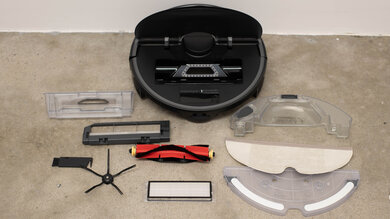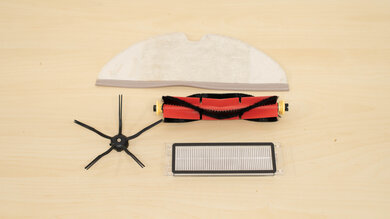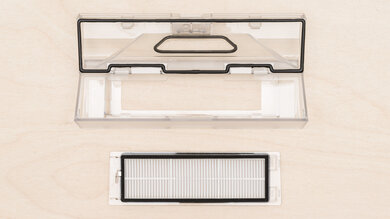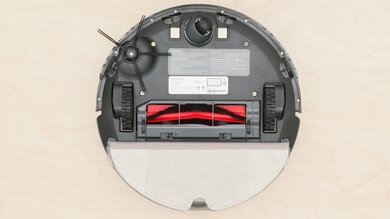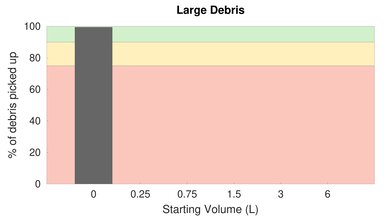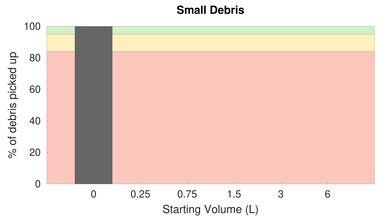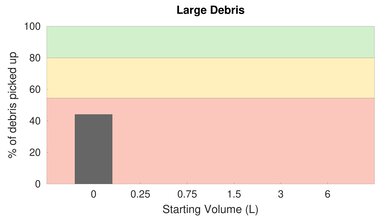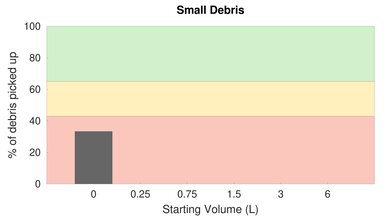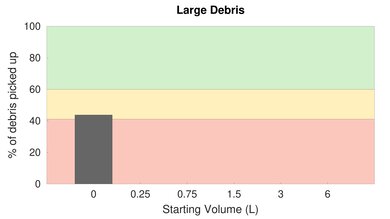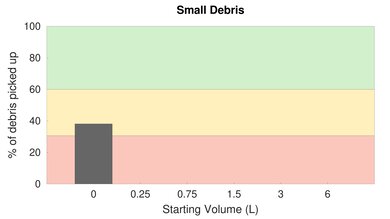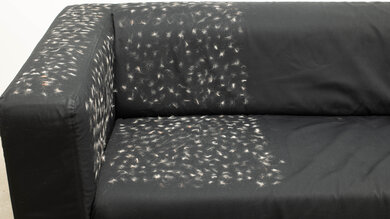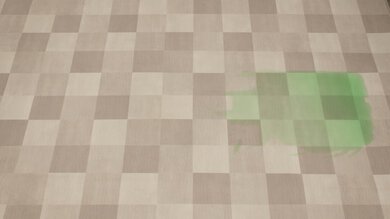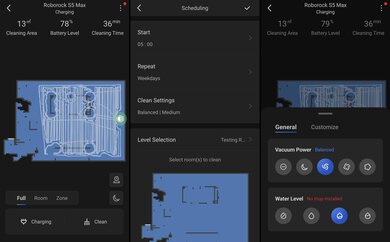The Roborock S5 Max is a mid-range robot vacuum within Roborock's extensive product lineup. It's an upgraded version of the discontinued Roborock S5, with a more advanced navigation and mapping system that allows it to clean specific rooms with custom suction and mopping settings. It also has an upgraded mopping feature that uses a larger water tank. However, it isn't compatible with self-emptying base stations and lacks the real-time hazard-avoidance capability found on newer, pricier models like the Roborock S7 MaxV.
Our Verdict
The Roborock S5 Max is very good for bare floors. It sucks up pet hair and small and bulky debris with minimal difficulty and does a great job maneuvering itself on bare floors. It also feels very well-built, with a dense plastic body and durable rubber wheels. Battery performance is fantastic, with a maximum runtime of over four hours, which is plenty of time for cleaning very large areas. Unfortunately, its mopping functionality isn't especially effective, as it does little to scrub away dried-on messes.
- Exceptional debris pickup performance on bare floors.
- Long battery life.
- Great build quality.
- Advanced automation features.
- Ineffective mopping feature.
- Many parts need regular cleaning.
- High recurring costs.
The Roborock S5 Max is an okay option for low-pile carpet. While its carpet-detection system allows it to automatically ramp up its suction power on carpets, it still struggles with clearing away fine and large debris on this surface type. Thankfully, it does a fantastic job of handling pet hair. Its LIDAR-based navigation system allows for quick and precise room mapping, and it does a great job of maneuvering itself. Battery performance is another high point, as it can run for over 90 minutes even in its most powerful 'Max' mode.
- Long battery life.
- Great build quality.
- Advanced automation features.
- Many parts need regular cleaning.
- High recurring costs.
- Struggles with fine and large debris.
The Roborock S5 Max is alright for cleaning high-pile carpet. It performs passably on this surface type, as it needs to make several extra passes to clear away most fine and large debris, though it has very little trouble dealing with pet hair. It feels impressively robust, and while it does have quite a few parts that need regular cleaning, they're very easy to access for the most part. Unfortunately, it can incur high recurring costs over time since quite a few pieces need periodic swapping out. It can also struggle to climb onto very dense shag-pile carpeting.
- Long battery life.
- Great build quality.
- Advanced automation features.
- Many parts need regular cleaning.
- High recurring costs.
- Struggles to climb onto shag-pile rugs.
The Roborock S5 Max is a solid option for dealing with pet hair on floors, with a few notable downsides. It's very effective in clearing away pet hair on bare floors and low and high-pile carpet, though its brushroll and side brush are very tangle-prone and can be a bit of a hassle to clean, even with the included hook-blade cleaning tool. It has a mopping attachment with different customization settings; however, it doesn't provide much surface agitation and has a very hard time scrubbing away dried-on stains. That said, the vacuum is effective at sealing in fine allergens like pet dander and makes very little noise, which is great for animals that are sensitive to loud sounds.
- Remarkably quiet operation.
- Fantastic pet hair cleaning performance.
- Ineffective mopping feature.
- No hazard avoidance.
- Many parts need regular cleaning.
- High recurring costs.
- Tangle-prone brushroll and side brush.
The Roborock S5 Max is a robot vacuum and isn't suitable for cleaning stairs.
The Roborock S5 Max is a robot vacuum and isn't suitable for cleaning the inside of your car.
The Roborock S5 Max is a robot vacuum and isn't designed for workshop cleaning.
Changelog
- Updated Dec 14, 2023: Converted to Test Bench 0.7.
- Updated Oct 17, 2022: We've corrected an error in this review stating that this vacuum has a HEPA-efficiency exhaust filter. This isn't the case, and all mentions of this vacuum having a HEPA filter have been removed.
- Updated Sep 23, 2022: We've set the 'Scheduled Start Buttons' field in the 'Physical Automation' section to 'No', as you need to use the vacuum's companion app to schedule a cleaning session in advance. All relevant scores and text have been updated.
- Updated Aug 16, 2022: Review published.
Check Price
Differences Between Sizes And Variants
The Roborock S5 Max is available in two color variants: 'Black' and 'White'. We tested the 'Black' variant, and you can see its label here.
Let us know in the discussions if you come across another variant of this vacuum, and we'll update our review.
Popular Robot Vacuum Comparisons
The Roborock S5 Max is a mid-range robot vacuum. Compared to the older Roborock S5, it offers a significantly upgraded mapping and navigation system that allows you to split its coverage area into different areas with tailored suction and mopping settings. It also has a larger water tank that won't need refilling as often. It sits alongside the newer Roborock Q5 in the lineup, with a less powerful suction motor and no self-emptying capability. However, it feels noticeably better built and has a mopping feature.
If you're looking for an alternative, look at our lists of recommendations for the best robot vacuums for hardwood floors, the best robot vacuums for pet hair, and the best robot vacuums for carpets.
The Roborock S6 MaxV is better than the Roborock S5 Max, though the S5 Max is a better option for value-conscious buyers. They deliver similar overall cleaning performance; however, the S6 MaxV feels better built and has a dual-sensor navigation system, which uses LIDAR to quickly map out its coverage area and front-facing cameras to let it identify and avoid hazards like pet waste in real-time.
The Roborock S5 Max is a big upgrade over the Roborock S5. The S5 Max has a more advanced navigation system that allows faster mapping, and you can specify different suction and mopping modes for specific rooms. It also has a larger water tank that won't need refilling as frequently.
The Roborock S7 is better than the Roborock S5 Max. The S7 feels better built and provides a more hands-off cleaning experience, as it's compatible with a self-emptying station out of the box. Its ultrasonic mopping feature also does a much better job of scrubbing away stains than the S5 Max's entirely passive system. It clears more debris on carpets thanks to its more powerful suction motor. While it's harder to clean, the S5 Max's bristled brushroll does a much better job handling pet hair than the S7's rubber roller. The S5 Max also has a bigger internal dustbin.
The Roborock S5 Max and the Roborock S4 Max are very similar vacuums that share the same overall mapping and navigation system, suction motor, and dirt compartment capacity. The only significant difference between the two is the inclusion of a mopping feature, as the S5 Max has a mopping attachment while the S4 Max does not. Ultimately, the S5 Max's mopping attachment isn't very effective, and unless you need it, you're better off spending less on the cheaper S4 Max.
Test Results

The Roborock S5 Max feels very well-built. Its glossy top cover and matte plastic bumpers give it a similar look to the Roborock S6, but without the brushed-metal finish for its LIDAR sensor. It uses a slightly different brushroll design than the older Roborock S5, with softer, more flexible bristles. It feels sturdy, as its body doesn't creak or flex when picked up. There are a few small weak points, however. The top cover to its dirt compartment will break if you overextend it while removing the dirt compartment, and the mop pad attachment can wear out over time.
Out-of-the-box setup isn't too difficult. You have to download the Roborock companion app to complete the setup process and pair the vacuum with its docking station. You'll also need to screw its side brush into place.
The Roborock S5 Max has quite a few parts that need regular cleaning, but thankfully it's designed in such a way that makes it easy to access these components.
- Dirt compartment: The dirt compartment can be removed by lifting the back cover of the vacuum and pressing the single release tab. The vacuum provides an audio notification to tell you when the dirt compartment has been removed or re-seated in its housing. You should empty it once a week or whenever you notice that it's full. You can also wash the dirt compartment under water to remove any stuck-on debris.
- Brushroll: You can access the brushroll by flipping the vacuum over and removing the brushguard, after which you can pull the brushroll free. It's pretty tangle-prone, and longer strands of hair can get wrapped not only around the middle of the brush but also the brushroll's cylindrical bearings, which can be quite tricky to clean, though they can be twisted free. You can use the included hook-blade cleaning tool to cut away any tangled hair from the brushroll's bristles. The brushroll needs cleaning twice a week or whenever you notice a significant debris buildup.
- Side brush: The side brush is a little trickier to remove than most other components, as you'll need to flip the vacuum over and remove the retaining screw holding it in place with a Philips-head screwdriver. Unlike most other robot vacuums' side brushes, like that of the Ecovacs DEEBOT OZMO T8 AIVI, tangled hair gets wrapped tightly around it and can't be slid free. You should clean it once a month or whenever you notice a degradation in sweeping performance.
- E11 filter: The filter is clipped onto the dirt compartment, and can you can pull it out with minimal effort. It has a simple design with well-spaced vanes, so clearing away any stuck-on dirt isn't too hard. You should wash it under water every two weeks, but make sure to let it dry for at least 24 hours before reinstalling it.
- Front wheel: The front wheel is another difficult-to-clean component. You'll probably need to use a pair of pliers to gain sufficient leverage, but be careful not to damage it by squeezing too hard. You have to clean it once a month, and it helps your vacuum move more smoothly.
- Mop cloth: The mopping cloth is velcroed to the mop mounting plate, which can be slid onto the vacuum and removed from the vacuum by pressing the two release tabs on either end. You should clean it under water after each use.
- Water tank: You can pull the water tank out from the back of the vacuum. You can clean it as required by rinsing it out with clean water.
- Sensors: If dust and debris are building up on the sensors, you can clean them with a dry cloth.
Any part washed with water should be allowed to dry for at least 24 hours before being put back in the vacuum.
The Roborock S5 Max incurs high recurring costs.
- Brushroll: The brushroll needs replacing after 300 hours of use. You can buy a replacement here.
- Side brush: The side brush has a service life of 200 hours. You can buy a replacement here.
- E11 filter: The filter needs replacing following 150 hours of use. You can buy replacements in packs of two here.
- Mop cloth: You should replace the mop cloth every three to six months. Replacements can be bought in packs of two and are available to buy here.
Most parts are also sold through Roborock's Amazon store.
The Roborock S5 Max is very easy to store. The vacuum has the same overall dimensions as many other Roborock vacuums and is consequently small enough to squeeze under most tables and chairs. Its charging station is also very low-profile, and it comes with a moisture-proof pad, so you don't have to worry about the vacuum's mop cloth soaking the floor when not in use.
The Roborock S5 Max has a reasonably large dirt compartment. It has a larger capacity than pricier models like the Roborock S7 MaxV; however, it's important to note that some pricier models are compatible with self-emptying stations, where internal dustbin capacity isn't as relevant since the vacuum will empty itself whenever it fills up. You'll receive an audio alert through the vacuum's companion app to let you know when it's full.
The Roborock S5 Max's range is limited only by the room left in its dirt compartment and the charge status of its battery. However, it can't climb or descend staircases.
The Roborock S5 Max is pretty portable. Its onboard water tank and all other associated mopping hardware make it heavier than vacuum-only models like the Roborock S4 Max, but it's still lighter than the flagship Roborock S7 MaxV.
The Roborock S5 Max has excellent battery performance. It can run for more than four hours in a single charge in its most energy-efficient 'Gentle' mode, which gives it plenty of time to deal with lightweight debris on bare floors. Its runtime drops to a little over an hour and a half when used in its high-power 'Max' mode, but this is still sufficient for dealing with larger stubborn messes. The vacuum stops cleaning once its charge level drops below 20%, at which point it refuses to take any more cleaning jobs and attempts to make its way back to its charging station.
The Roborock S5 Max robot vacuum has a handful of quality-of-life features. There are five different power suction modes: the low-power 'Gentle' mode, the slightly more potent 'Quiet' mode, the default 'Balanced' mode, the 'Turbo' mode for cleaning heavier debris, and 'Max' for dealing with stubborn messes or debris embedded deeply within carpet fibers. You can also tweak the water flow for its mopping attachment through four settings: 'Close', 'Low', 'Medium', and 'High'. The 'Carpet Mode' feature allows the vacuum to automatically detect when it's cleaning the carpet and increase the suction power mode to 'Max'. This feature is turned on by default, but you can turn it off in the app.
The Roborock S5 Max has a five-arm silicone side brush to direct debris into the path of its brushroll. It also comes with a hook-blade cleaning tool for cutting away tangled hair. There's also a washable mop cloth attachment for scrubbing away stains. You can place the included rubber floor pad under the charging dock to keep water from its mop cloth from dripping onto your floor when it isn't in use.
The Roborock S5 Max performs exceptionally well on bare floors in its default 'Balanced' mode. It easily clears away small debris like rice and bulkier material like cereal.
The Roborock S5 Max's performance on low-pile carpet is middling. It has a hard time with large debris like sand and finer material like baking soda.
The Roborock S5 Max performs passably on high-pile carpet. It clears away a fair amount of larger debris like sand and finer material like baking soda, but it'll still need to make an extra pass or two to fully clear away all of it.
The Roborock S5 Max has relatively good suction force for a robot vacuum, though not quite as much as pricier models like the Roborock S7 MaxV. Like most other robot vacuums, its suction inlet is positioned too high above the contact surface to create a tight seal, so real-world suction measurements are low.
The Roborock S5 Max is exceptionally quiet. You'll hear what people nearby are saying when the vacuum is running in its most powerful suction mode, and when you use it in its low-power 'Gentle' mode, you'll have little trouble carrying on a normal conversation even when the vacuum is very close to you. It's substantially quieter than the more powerful Roborock S7 MaxV.
The Roborock S5 Max's maneuverability is great. It cleans in an organized pattern that ensures pretty comprehensive coverage, but it's worth noting that its movement is noticeably choppier than newer Roborock vacuums. Still, its side brush is effective in dragging debris from the edges of a room into the path of its primary brushroll. It's also short enough to clean under most couches. It's capable of mapping out its coverage area as it cleans, but it's important to remove its mopping attachment before letting it do so for the first time. Unfortunately, it can have a hard time cleaning tasseled rugs, which can get tangled in its brushroll, and shag-pile carpeting, which it has trouble climbing over.
The Roborock S5 Max does a good job of sealing in fine allergens. Unlike the Roborock Q5, fine particles aren't blown free of its LIDAR sensor while it cleans.
The Roborock S5 Max does a poor job scrubbing away stains. Unlike the pricier Roborock S7 MaxV, which uses a separate motor to vibrate its mop pad and physically scrub away stains, the S5 Max uses an entirely passive system that effectively consists of a damp mop cloth being dragged behind it. Even running multiple cycles does little to impove its stain-cleaning performance, and you can see the result of eight passes here.
The Roborock S5 Max has a decently wide range of physical automation features. You can technically use the vacuum with its two control buttons without needing an internet connection and its associated companion app, but you're losing out on most of its features by doing so. Pressing and holding the power button turns the vacuum off while tapping it has it start and stop a cleaning session. Tapping the 'Home' button sends it back to its dock, and you can hold it down to have the vacuum spot-clean a small area. Unlike the Roborock Q5, it isn't self-emptying compatible, so you'll have to empty its dustbin manually once it's filled up.
The Roborock S5 Max's companion app is fantastic. The vacuum offers multi-level mapping, letting it store up to four different floor plans, meaning you can use it on any floor of your home. Its LIDAR sensor can recognize what floor plan it's on based on the furniture within. You can access its coverage map though its easy-to-use companion app to set up virtual boundary lines and 'No-Go' zones that you don't want the vacuum to enter, or even set up 'No-Mop' zones for areas that you don't want mopped. You can tweak the suction mode and water flow rate for its mopping feature for specific rooms or even create a custom schedule for cleaning individual areas.


